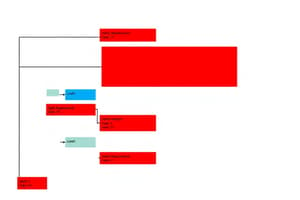Podcast
Questions and Answers
What does an Entity-Relationship Diagram (ERD) primarily focus on?
What does an Entity-Relationship Diagram (ERD) primarily focus on?
- How data will be stored
- The relationships between data and what data needs to be stored (correct)
- The performance of database queries
- The technology used for database management
A primary key can have duplicate values within an entity.
A primary key can have duplicate values within an entity.
False (B)
What symbol is used to represent a weak entity in an ERD?
What symbol is used to represent a weak entity in an ERD?
double rectangle
In an ERD, the __________ represents the properties that describe an entity.
In an ERD, the __________ represents the properties that describe an entity.
Match the following terms with their definitions:
Match the following terms with their definitions:
Which step is NOT part of the normalization process?
Which step is NOT part of the normalization process?
The physical database design stage is focused on translating the logical database design into a physical schema that includes performance and storage considerations.
The physical database design stage is focused on translating the logical database design into a physical schema that includes performance and storage considerations.
What is the purpose of defining indexes in a database?
What is the purpose of defining indexes in a database?
When designing a database, foreign keys are used to maintain _________ integrity between tables.
When designing a database, foreign keys are used to maintain _________ integrity between tables.
Match the following concepts to their descriptions:
Match the following concepts to their descriptions:
Flashcards are hidden until you start studying
Study Notes
Conceptual Database Design
- ERD is a high-level representation of data and its relationships.
- Entity-Relationship Diagrams (ERD) visually represent the data for easy understanding.
- Conceptual Model is independent of any database management system (DBMS) or technology and focuses on WHAT data needs to be stored rather than HOW it will be stored.
Key Concepts in ERD
- Entities represent real-world objects or concepts that store data and are often represented as rectangles.
- Attributes describe an entity and are often represented as ovals.
- Primary Key (PK) uniquely identifies each instance of an entity and is underlined in ERD.
- Relationships define how entities are related to each other. Types:
- One-to-one (1:1)
- One-to-many (1:N)
- Many-to-many (M:N)
- Cardinality defines the number of occurrences in one entity that are associated with occurrences in another entity.
- Weak Entities cannot be uniquely identified by their attributes and depend on another entity. They are represented by a double rectangle.
- Example ERD Components
- Entities: Student, Course, Instructor
- Relationships: Enrollment (many-to-many), Teaches (one-to-many)
- Attributes: StudentID, Name, CourseID, Credits, etc.
Logical Database Design
- Translates the conceptual model into a logical model that can be implemented in a DBMS.
- Uses the rules of the specific data model, commonly the relational model.
- Normalization ensures data integrity and avoids redundancy by organizing data into tables following normal forms (1NF, 2NF, 3NF).
- Mapping Entities to Tables converts entities into tables and defines primary keys.
- Define Relationships as Foreign Keys translates relationships from the ERD into foreign keys to maintain referential integrity between tables.
- Specify Attributes and Data Types identifies data types and constraints (e.g., integer, varchar, NOT NULL, UNIQUE). This stage is closer to how data will be stored in a relational database but still DBMS-independent.
Physical Database Design
- Translates the logical database design into a physical schema considering performance, storage, and specific DBMS optimizations.
- Map Tables to the DBMS - Creates tables in the chosen DBMS (e.g., MySQL, Oracle, SQL Server) using SQL syntax.
- Define Indexes improve query performance by adding indexes to frequently queried columns (e.g., primary keys, foreign keys).
- Partitioning and Clustering optimize performance by partitioning large tables and clustering data to minimize disk I/O.
- Storage and Security determines storage settings (e.g., file locations, space allocation) and applies security measures like user permissions and encryption.
- Performance Tuning optimizes queries, indexes, and resource usage based on the anticipated workload.
- By the end of the physical design, the database is fully implemented and ready for testing and use.
Studying That Suits You
Use AI to generate personalized quizzes and flashcards to suit your learning preferences.




